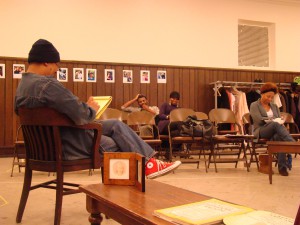 We’ve completed our second week of rehearsal. Each day, someone brings in something delectable to eat to share with our little family: clementines or caramel corn or cake. And we continue to flesh out this intensely personal play, even as tragedy strikes in Haiti and Ron and the actors have a moment of silence for the passing of their friend and colleague, the actor Paul Butler.
We’ve completed our second week of rehearsal. Each day, someone brings in something delectable to eat to share with our little family: clementines or caramel corn or cake. And we continue to flesh out this intensely personal play, even as tragedy strikes in Haiti and Ron and the actors have a moment of silence for the passing of their friend and colleague, the actor Paul Butler.
John Henry Redwood had a PhD in religion, and religion figures prominently in his plays. As Ron has pointed out, “the church is an important character in The Old Settler.” The moment we meet the sisters, they have come from a funeral at their church. Ron states, “it’s a typical Black church, with big hearts, lots of love and worship…. and of course, cliques, gossip and rumors.” Quilly and Elizabeth speak about Sister Laidlaw, Sister Wallace, Deacon Slater and other characters whom we never meet but who form the fabric of the church community to which they belong. Cheryl Lynn and Wandachristine mused that one of the first things their own families do after moving from one house to another is “find a church home.”
Cheryl Lynn reflected, “my favorite part of church is the devotional: usually the older folks arriving before the official service and taking part in thanking the lord, singing and calling, each in turn, responding to one another with their eyes closed.” This music lingers, to be sure: each time we rehearse “Satan, We’re Gonna Tear Your Kingdom Down,” a deliciously palpable energy remains in the rehearsal room.
Redwood also held a degree in history and he vividly paints 1943 Harlem in The Old Settler. The audience sees this historic New York through the eyes of Husband, who has come from the sea islands of South Carolina. The sisters (and the City itself) teach the young man about some of the particulars of the time: “pimp steaks,” “swamp seeds” and “Kitchen Mechanics’ Night.” The characters speak in their own particular, historic vernacular. “Redwood is a Wilsonite,” Ron explained. He definitely drew from what August Wilson was doing, both in terms of poetic language as well as historical significance.
The play also explores the conditions in pre-civil rights New York. Even though they are in the North, Elizabeth warns, the situation is not necessarily better for African-Americans, “in many ways it’s worse.” 1943 is a tumultuous year and, as Ron pointed out, “even though the play is not about that specifically, the effects of these conditions are brought into the apartment by the characters.” For instance, Redwood touches on the propaganda created by whites using the fear of venereal disease and crime occurring at the Savoy Ballroom to try to get it closed down, presumably because white men were upset about white women dancing with black men. This is the world into which Husband is plunged when he finally finds his Lou Bessie.
Ron describes the process of crafting a play in terms of human development: “we’re embryos right now and we’re growing,” he has said. He continues to draw life experience from the actors. He has also invited them to include their own old photographs among the numerous frames Elizabeth keeps in her home. Even images of Ron and his grandfather are going to make an appearance on the set.
Until next week!
Jack
Assistant Director


No comments yet.